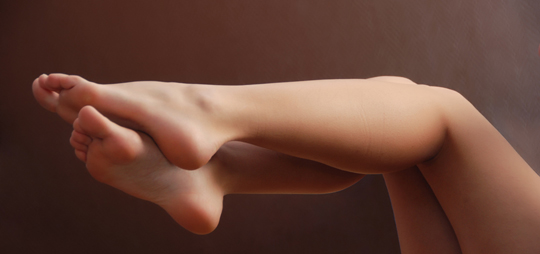VEINS
Varicose veins are extremely widespread within our population, since it is estimated that they concern 30 to 50% of women and 20 to 30% of men. This condition will be increasingly frequent because of the ageing of the population and lifestyle changes.
CAUSES OF VARICOSE VEINS
Venous insufficiency is related to a weakness of the venous wall, probably hereditary. This weakness will worsen gradually by factors of risks: jobs involving prolonged standing positions, putting on weight, pregnancy, heat, etc…
The venous wall dilates, causing its valves to separate. As a result, blood flow reverses. Instead of bringing blood back to the heart as a normal vein would, a weakened vein allows blood to become static in the lower extremity. This backward flow will involve an increase in pressure in the vein (hypertension). Dilation becomes permanent: it is a varicose vein. This phenomenon will extend gradually and, if allowed to continue, will affect an increasingly wide surface venous network.
SIGNS/SYMPTOMS OF VENOUS DISORDER
• Aesthetic problem, sometimes neglected at the beginning of the disease.
• Problem of discomfort that disturb daily activities (feelings of aching, tiredness) and at night (a percentage of restless legs syndrome RLS is due to venous insufficiency).
• Medical problem with early or late cutaneous and circulatory complications.
WHAT WE DO:If you have varicose veins, we perform a Duplex (color flow) ultrasound examination to determine the source of the problem. The advent of ultrasound imaging has taught that the entire Saphenous vein may not reflux, and rather that a non-Saphenous, Accessory Saphenous vein may be responsible for the distal venous hypertension. A vascular surgeon in Nice, France has refuted the principle of Saphenous ablation by taking away the varicose tributaries to the Saphenous vein thus decreasing its reflux flow and allowing the vein to decrease in diameter and regain competence. He observed that Saphenous vein reflux disappeared after correction of superficial vein reflux, with associated functional and aesthetic benefits.
Next, we inject a drug that sensitizes the inner vein walls causing the vein to collapse in on itself. The patient’s body eventually absorbs the shrunken vein.Click Here to download video
(Mac Users will need to download video to desktop in order to view)
If you have telangiectasias (aka spider veins), we look for the source and treat the underlying reticular veins. If the source is not treated, the spider veins will soon return. For select cases of telangiectasias of the face and legs, we use a laser that has a patented cryogen cooling system that anesthetizes the skin before, during, and after treatment.
Why our techniques are superior
For a very long time, the methods of treatment of the varicose veins evolved little. The aggressiveness of the surgical treatment (size of scars, duration to resume normal activities, etc) and the frequency of recurrence very often discouraged the patients. Later, electromagnetic energy (endovenous laser and radiofrequency) was used as a means of taking saphenous veins out of the circulation. Unfortunately, since energy can radiate outside the vein wall, cases of nerve damage were reported. In addition, reports of recurrent varices in ~30% of these cases are making some physicians look to alternatives in treating varicose veins.
Our medical treatment of varicose veins involves innovative techniques and our objectives are to be preventative, less aggressive and more precise. This now makes it possible for the patients to be better treated, earlier, and with a better follow-up care.
If you plan to visit us and want to expedite your first visit, download this form. Please fill it out, and bring it with you to your schedule appointment.
Pregnancy and Varicose Veins
Many young female patients come to me and ask why they have varicose veins when they thought it was suppose to be an “old person’s disease.” The first thing I ask them is how many times they were pregnant. I emphasize here that the number of pregnancies matters more than the number of births. The pathophysiology to developing varicose veins is two-fold.
First, every time a woman gets pregnant, her body releases a lot of progesterone (a common female hormone). Progesterone dilates the veins of a woman’s uterus to accept the incoming baby, but then progesterone dilates ALL veins. As a result, leg veins bulge out. The second reason is that as a woman’s uterus grows, it presses on a major vein called the inferior vena cava (IVC). Back pressure in the IVC causes back pressure in the veins that drain into it, including leg veins.
For many pregnant woman, the varicose veins improve after pregnancy. However, for those that do not, treatment is available. In the above section, I briefly describe what is involved in the safe removal of these problematic veins. As I point out to many symptomatic patients. Varicose veins are not simply a cosmetic issue.
Other vein problems after pregnancy: PELVIC VEINS
Pelvic obstruction may be a cause of vulvar varicosities. This can occur in the third trimester. Vulvar varicosities that remain after pregnancy may become quite painful, usually during menses or even intercourse. They are easily treated with sclerotherapy, usually with complete resolution.
Athletes and Varicose Veins
I am always asked by my patients whether exercising will increase symptoms of varicose veins. The answer is not straight forward. While some European studies show that performance can be affected by varicose veins, others argue that the increase in muscle contractions can improve venous return to the heart.

